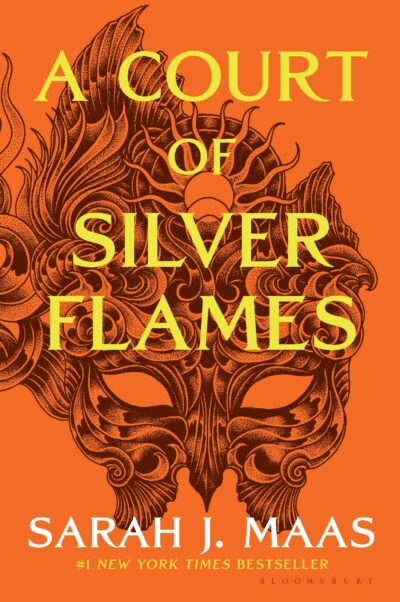
A Court of Silver Flames
Chapter Seventy-Five
by J, Maas, SarahThe chapter opens with a tense moment as Cassian lies motionless on the ground, prompting Nesta to rush to him in distress, fearing the worst. Her panic turns to relief when she discovers the knife beneath him is unbloodied, and Cassian reveals he was merely lying low during her powerful display of magic. Their emotional reunion is marked by Nesta’s tears and Cassian’s soothing words, as he acknowledges her triumph over Briallyn, who has been unmade. The Crown, now a black stain on the earth, symbolizes Nesta’s victory and the end of their immediate threat.
Nesta and Cassian share a tender moment, declaring their bond as mates through a heartfelt kiss that transcends their surroundings. The intensity of their connection is palpable as their souls intertwine, glowing with mutual joy and awe. This intimate scene underscores the depth of their relationship, contrasting sharply with the chaos of their recent battle. Their happiness, however, is short-lived as the arrival of Mor and Azriel interrupts the moment, hinting at new complications.
The mood shifts abruptly as Mor and Azriel land nearby, their grave expressions signaling urgent news. Cassian immediately inquires about Eris, learning that while he is safe and the Made dagger has been recovered, tensions remain high. The focus then shifts to Feyre, whose name is dropped ominously by Mor, suggesting a new crisis. This cliffhanger ending leaves readers anticipating the next development, as the characters’ hard-won peace is once again threatened.
The chapter masterfully balances emotional resolution with impending conflict, showcasing Nesta’s growth and her bond with Cassian while setting the stage for further challenges. The juxtaposition of their personal joy against the broader threats they face highlights the ongoing stakes in their world. The abrupt ending ensures the narrative momentum continues, leaving readers eager for the next chapter.
FAQs
1. What was the outcome of Nesta’s confrontation with Briallyn, and how did Cassian react to it?
Answer:
Nesta successfully Unmade Briallyn, as evidenced by the black stain where Briallyn had been and the untouched knife lying on the ground. Cassian, who had lain facedown to avoid interfering, initially feigned injury but then revealed he was unharmed. His reaction was one of awe and admiration, calling Nesta his mate and kissing her passionately. Their emotional exchange highlights the depth of their bond, with Cassian’s joy mirroring Nesta’s relief and triumph (Chapter 75).2. How does the chapter portray the significance of the “mate bond” between Nesta and Cassian?
Answer:
The mate bond is depicted as a profound, soul-deep connection. When Nesta declares Cassian as her mate and kisses him, their souls visibly twine and glow, emphasizing the mystical and emotional union. Cassian’s reverence (“You are my mate”) and their shared joy underscore the bond’s transformative power. The scene contrasts their earlier struggles, showing how their relationship has evolved into one of mutual recognition and love, transcending the surrounding chaos (Chapter 75).3. What narrative purpose does the interruption by Mor and Azriel serve at the chapter’s end?
Answer:
Their abrupt arrival shifts focus from Nesta and Cassian’s intimate moment to a new crisis involving Feyre, creating suspense and propelling the plot forward. This interruption juxtaposes personal triumph with external urgency, reminding readers of unresolved conflicts. Mor’s grave tone and the mention of Feyre suggest impending danger, heightening tension while delaying resolution—a technique to maintain reader engagement (Chapter 75).4. Analyze the symbolism of the Crown left on the ground after Briallyn’s defeat.
Answer:
The discarded Crown symbolizes the futility of Briallyn’s power and ambition. Its presence near the black stain (her remains) reinforces her ultimate defeat, while its abandonment reflects Nesta’s rejection of the toxic legacy it represents. The Crown, once a tool of control, becomes a mere object, underscoring the chapter’s theme of reclaiming agency—Nesta’s victory is not just physical but ideological (Chapter 75).5. How does Cassian’s humor (“I figured I should lie low”) contrast with the chapter’s darker themes?
Answer:
His lighthearted remark provides emotional relief amid the gravity of Briallyn’s demise and the mate-bond revelation. This contrast highlights Cassian’s role as Nesta’s stabilizer, using humor to diffuse tension. It also humanizes the characters, reminding readers that even in epic battles, personal connections and levity endure—a hallmark of the series’ balance between intensity and warmth (Chapter 75).
Quotes
1. “Nesta rushed toward him, praying, sobbing, her magic still echoing through the world.”
This quote captures the emotional climax of the chapter, showing Nesta’s raw desperation and power as she believes Cassian has been fatally wounded. It highlights her transformation and the lingering effects of her magic.
2. “She had it coming.”
Nesta’s blunt statement about Briallyn’s demise demonstrates her hardened character and the justice she delivered. This short but impactful line reveals her no-nonsense attitude even in victory.
3. “You are my mate, Cassian… And you’re mine.”
This tender exchange marks the official acknowledgment of their mate bond, representing a pivotal emotional breakthrough for both characters after their long journey. The mutual declaration shows their equal commitment.
4. “It did not matter, the world around them, or the Crown at her feet, as he kissed her. A mate’s kiss. One that set their souls twining, glowing.”
This beautifully written passage captures the transcendent nature of their bond, emphasizing how their connection overshadows even their recent victory. The description of their souls “twining” poetically conveys the depth of their union.
5. “It’s Feyre.”
This abrupt ending quote creates dramatic tension, shifting from the romantic resolution to hint at new troubles ahead. The sudden interruption serves as both a cliffhanger and a reminder that their personal victories exist within larger conflicts.
